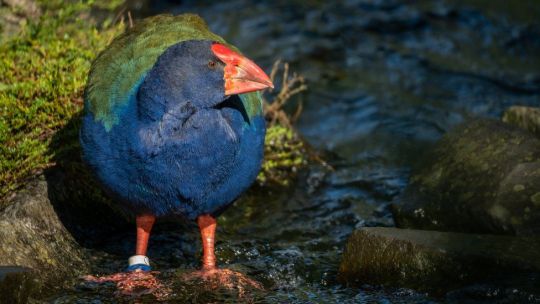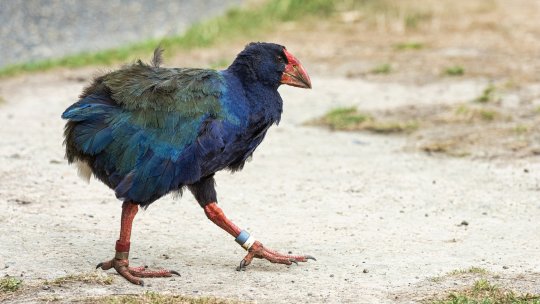#Porphyrio hochstetteri
Explore tagged Tumblr posts
Text

South Island takahē (Porphyrio hochstetteri)
© Aaron Skelton
874 notes
·
View notes
Text



Takahē
36 notes
·
View notes
Text



#poll#Class: Aves#Order: Gruiformes#Family: Rallidae#Genus: Porphyrio#Porphyrio Hochstetteri#Range: Australasian#btw these are often just called the Takahē#because the only other Takahē is the North Island Takahē (Porphyrio mantelli) which is extinct
33 notes
·
View notes
Text

#artists on tumblr#art#illustration#artwork#myart#original art#digital art#takahē#takahe#bird#birds#birb#birbs#digital illustration#animal art#new zealand birds#birdblr#Porphyrio hochstetteri#lazarus taxon#Text Credit: Paul Wignall#Text Credit: Michael Benton
19 notes
·
View notes
Note
🥚if you’re still doing these <3


South Island takahē!
(Porphyrio hochstetteri)
55 notes
·
View notes
Text
Evolved them in isolation with almost no mammals around so they could be weird in peace
ok like kakapo are great and all, i love them dont get me wrong but takahē are by far the best endangered new zealand bird and quite possibly THE Best Bird?



you cant really get any better than this. criminally underrated
66K notes
·
View notes
Note
I see a bunch about the pukeko who are all over my back yard, but I'd love it if you posted some pics of the Takahe, their puppet headed bigger daddy. <3



Takahē (Porphyrio hochstetteri), family Rallidae, order Gruiformes, found in isolated areas of New Zealand
ENDANGERED.
photos: Pseudopanax (1,3), ZEALANDIA Ecosanctuary
352 notes
·
View notes
Text

Takahe (Notornis mantelli)

takahe, (Porphyrio hochstetteri), rare flightless bird of New Zealand that was thought to have become extinct in the late 1800s but that was rediscovered in 1948 in several remote valleys on South Island. Given that fewer than 250 mature birds remain and only on small islands, the International Union for Conservation of Nature and Natural Resources has classified the takahe as an endangered species.
https://www.britannica.com/animal/takahe
53 notes
·
View notes
Text


#my polls#tumblr polls#polls#animal polls#poll blog#animals#new zealand birds#birds#birdblr#bird#takahe#endangered species#endangered#swamphen#flightless bird
50 notes
·
View notes
Text
#2744 - Porphyrio hochstetteri - South Island Takahē



Quammen and Paku, the breeding pair at Orokonui Ecosanctuary, and two of their chicks.
AKA Notornis mantelli hochstetteri and Porphyrio mantelli hochstetteri.
A flightless Rail, and the world's largest living species in the family. Endangered, and believed hunted to extinction by 1898, then rediscovered in 1948 around Lake Te Anau in the Murchison Mountains. The North Island Takahē or Moho (Porphyrio mantelli) didn't have the same luck.
They lost most of their lowland habitat as swamplands were destroyed for agriculture, and in the wild now live only in alpine tussock grasslands, moving down into forests in winter. Deer remain serious competitors, leading to culling programs in the Murchisons.
Breeding pairs have been sent to refuges around the country, to try and preserve the species should anything else befall the wild birds. Inbreeding even in the wild population has unfortunately lead to serious fertility problems, on top of their slow reproductive rate.
Orokonui Ecosanctuary, Aotearoa New Zealand
3 notes
·
View notes
Text
Now I'm wondering why Porphyrio hochstetteri re-evolved that ability where the other swamphens did not. Something about the island insular population, perhaps? They're one my favorite birds, and one of the best examples of modern conservation's effectiveness. An ancient, human-friendly species that was though to be entirely extinct by the 1890's. Until a small population was discovered in the Murchison mountain range of Te Waipounamu in 1948. Conservation in the period was limited, and often fraught with rows over interventionism versus attempting to allow the species to return by themselves. Politics manages to get in the way of many a good deed, doesn't it. Ultimately, the involved choice was made to set up multiple island sanctuaries: away from the invasive deer, stoat, and cats that poach their eggs and trample grasslands. They made the correct choice, in the long term, for the species.
Regardless, from just about one hundred birds to a increasing population of four hundred and forty as of 2021 is an astounding rebound.
They're the largest of their family, and they sound like the soft noises of a brass trumpet. I adore them.
youtube
8 notes
·
View notes
Text
South Island takahē (Porphyrio hochstetteri)

789 notes
·
View notes
Text
De-novo genome assembly of four rails (Aves: Rallidae): a resource for comparative genomics
The rails are a phenotypically diverse family of birds that includes around 130 species and displays a wide distribution around the world. Here we present annotated genome assemblies for four rails from Aotearoa New Zealand: two native volant species, p[u]keko Porphyrio melanotus and mioweka Gallirallus philippensis, and two endemic flightless species takah[e] Porphyrio hochstetteri and weka Gallirallus australis. The quality checks and comparison with other rallid genomes showed that the new assemblies were of high quality and that the annotations could be trusted. Using the sequence read data, heterozygosity was found to be lowest in the endemic flightless species and this probably reflects their relatively small populations. This study significantly increases the number of available rallid genomes and will enable future genomic studies on the evolution of this family. http://dlvr.it/T0bxVM
0 notes
Text

La historia del takahé (Porphyrio hochstetteri) es el ejemplo de cómo un programa de conservación es capaz de recuperar especies que se habían dado completamente por perdidas, como es el caso de esta ave no voladora neozelandesa, que desde el siglo XIX se consideraba extinta.
Esta especie prehistórica de la Isla Sur de Nueva Zelanda, característica por tener un pico rojo intenso y un plumaje azul muy llamativo, se ha convertido en todo un símbolo para los conservacionistas porque supone la ‘resurrección’ de una especie declarada extinta en 1898 y que en la actualidad cuenta ya con más de 440 ejemplares, según los últimos datos del Departamento de Conservación de Nueva Zelanda, que datan de 2021.
La vuelta a la vida del takahé se remonta a 1948, cuando el físico Geoffrey Orbell junto a su equipo descubren los últimos ejemplares silvestres de esta especie, que entonces se presumía extinguida desde hacía 50 años. Los últimos supervivientes de esta especie se avistaron en las praderas de las montañas Murchison, sobre el lago Te Anau, en la región de Fiordland.

El ave ya cuenta con más de 400 ejemplares ZOOCHAT
El descubrimiento de Orbell puso en marcha un largo programa de conservación, que en un principio se centró en la protección de la especie en cuatro islas libres de depredadores (Te Hoiere, Mana, Kapiti y Tiritiri Matangi) y que vivió uno de sus principales hitos con la creación del Centro Burwood Takahé, donde se incubaron artificialmente huevos silvestres y se criaron antes de devolverlos a su hábitat.

Primer plano de la cabeza del ave M. C. TOBIAS
No fue un proceso corto ni tampoco sencillo, ya que la recuperación vivió serios altibajos, en especial en 2007, cuando una plaga de armiños redujo a la mitad la población de takahé en las montañas Murchison. Ya en 2016 se consigue recuperar el número de ejemplares y mantener un crecimiento constante de la población de takahé.
Aves espirituales
Según detalla el propio Departamento de Conservación de Nueva Zelanda, el takahé tiene un “especial significado cultural, espiritual y tradicional” para los Ngāi Tahu, los iwi, una tribu maorí de la mayor parte de la Isla Sur de Nueva Zelanda.
El vínculo entre la tribu y este ave es tan estrecho que llegan a considerar al takahé como un “taonga” (tesoro) e incluso ejercen de “kaitiaki” (guardianes) en colaboración con el Departamento de Conservación del país para asegurar la protección de la especie.
Esta especie puede vivir entre 16 y 18 años en libertad y entre 20 y 22 años si reside en un santuario. Suelen vivir en praderas, salvo cuando nieva con intensidad y se generan capas de nieve gruesas, lo que les obliga a desplazarse hacia zonas de bosque. Comen hojas ricas en almidón procedentes de matas y juncos.
1 note
·
View note
Photo

South Island Takahe
279 notes
·
View notes